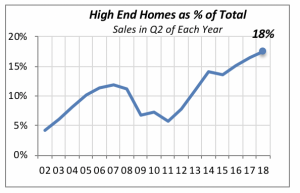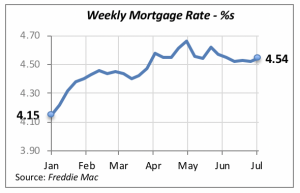Home Sales Fall in June
Contrary to most indicators pointing to the robust state of the American economy, sales of existing homes continue to linger at somewhat anemic levels. For instance, the employment picture shows that job growth has been consistent month after month, and virtually any individual who wants a job can get one. Yet home sales are faltering. Sales of existing homes fell 0.6% in June to an annualized rate of 5.38 million units changing hands. This is the third consecutive month of sales declines, amounting to a cumulative drop of nearly 4% since March, when the rate was 5.6 million units.

One of the factors that has stymied a greater volume of home sales is the relatively low inventory of homes on the market. While inventories have increased since the end of last year, when they hit a low of 1.46 million available homes for sale, this translates into a number of homes for sale that would last only 3.2 months at December’s pace. Currently, there are 1.95 million units for sale, still at levels not adequate to satisfy current demand.
Lower inventories are also pushing up prices. The average price of an existing home sold in June was $314,900 — nearly 4% higher than the previous month — which might shut some potential buyers out of the market.
Sales of New Houses Also Falter
More dramatic than the drop in existing home sales is the 5.3% drop in the number of new homes sold. June’s sale pace was virtually the same as the average of the preceding 12 months, when they reached a rate of 634,000 units. Moreover, as the graph below shows, June sales were the lowest since October 2017.

Unlike the floundering sales of existing homes, where low inventories are blamed partly for the decline, lack of inventory cannot be faulted for poor sales of new homes. This is because the market, i.e. builders, can respond to strong demand fairly rapidly.
Compared to a year ago, sales of new homes are only slightly better: 2%. Three of the four U.S. regions drove the market down in June, while sales in the Northeast jumped by nearly 39%. But this region accounts for only 8% of the houses sold. Thus, this impressive jump is immaterial on a national basis.
High-End Home Sales Rise
The good news for NKBA members is that sales of high-end homes continue to increase. High-end homes are defined as those selling for $500,000 or more. Sales in the second quarter rose to 32,000 units — 14% more units than were sold in the same quarter last year. For the first half, a total of 61,000 high-end homes have been sold, up 11% from last year.
As seen in the chart below, consumers continue to move toward higher-priced homes. For the second quarter of this year, 18% of all new homes sold were high-end — the highest percentage ever recorded.

The increase in high-end home sales comes at the expense of entry-level homes; that is, new homes sold for under $250,000. Their share of the total has fallen to just 15% this year, while they accounted for well over a third of the new homes sold 10 years ago. This could be owing to general inflation over the past decade, or to low inventories pushing up prices.
GDP Growth
The U.S. economy roared in the second quarter, with GDP posting a remarkably strong 4.1% growth. It’s been several years since the economy posted such high growth rates. In fact, the last time there was similar growth was four years ago, in the second and third quarters of 2014.

While the press largely attributes the growth to consumer expenditures, which reached 4% in Q2, all major components of GDP contributed to the vigorous second-quarter performance. Business investment, a key factor driving future prosperity, posted a solid 7.3% growth. Exports rose by 9.3%, while imports, which have been blamed for the declines in manufacturing employment, rose by a nearly negligible 0.5%.
Mortgage Rates Inch Up
Last week, the 30-year fixed mortgage rate moved up by two basis points (0.02%) to 4.54 —still around the same general level they’ve been over the last month or so.
Although they are higher than they were at the beginning of the year, the modest changes over the last three to four months can’t be blamed for poor performance in the housing markets. It’s generally weak inventory that is not allowing greater volumes of home sales.

Manuel Gutierrez, Consulting Economist to NKBA
Explanation of NKBA’s Economic Indicators Dashboard
The dashboard displays the latest value of each economic indicator with a colored triangle that highlights visually the recent trend for each of the drivers. “Green” is a positive signal, indicating that the latest value is improving; “Yellow,” as it’s commonly understood, denotes caution because the variable may be changing direction; “Red” indicates that the variable in question is declining, both in its current value and in relation to the recent past.
Note that all the data, except for “mortgage rate” and “appliance-store sales” are seasonally adjusted and are represented at annual rates.
Remodeling Expenditures. This is the amount of money spent on home improvement projects during the month in question. It covers all work done for privately owned homes (excludes rentals, etc.). The data are in billions of dollars and are issued monthly by the U.S. Department of Commerce.
Single-Family Starts. This is the number of single-family houses for which construction was started in the given month. The data are in thousands of houses and are issued monthly by the U.S. Department of Commerce.
Existing-Home Sales. These data are issued monthly by the National Association of Realtors and capture the number of existing homes that were sold in the previous month.
High-End Home Sales. This series are sales of new homes priced at $500,000 and higher. The data are released quarterly by the U.S. Department of Commerce and are not seasonally adjusted. Thus, a valid comparison is made to the same quarter of prior year.
Mortgage Rate. We have chosen the rate on 30-year conventional loans that is issued by the Federal Home Loan Mortgage Corporation (known popularly as Freddie Mac.) Although there are a large number of mortgage instruments available to consumers, this one is still the most commonly used.
Employees in Residential Remodeling. This indicator denotes the number of individuals employed in construction firms that do mostly residential remodeling work.
Building-Materials Sales. These data, released monthly by the Department of Commerce, capture total sales of building materials, regardless of whether consumers or contractors purchased them. However, we should caution that the data also includes sales to projects other than residential houses.
Appliance-Store Sales. This driver captures the monthly sales of stores that sell mostly household appliances; the data are stated at an annual rate. We should not confuse this driver with total appliance sales, since they are sold by other types of stores such as home centers.
We hope you find this dashboard useful as a general guide to the state of our industry. Please contact us if you would like to see further detail.








